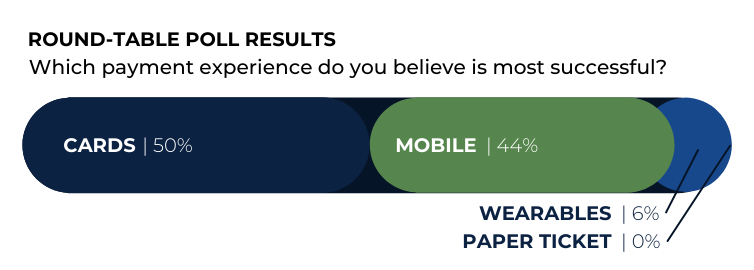Payments as the main enabler for Mobility as a Service: five essential takeaways from the round-table discussion

When assessing the current state of MaaS around the globe, there is impressive progress being made in a few cities where minds and data are open. A quotation from American-Canadian writer William Gibson, father of the cyberpunk sub-genre of science fiction, comes to mind. “The future is already here; it’s just not evenly distributed.”
The hour-long, closed session heavily featured the expert insights of Roberto Andreoli, IT and Ticketing Systems Director of Azienda Transporti Milanesi (ATM), the local transport authority for Milan, and Rome-based Emiliano Doveri, Director of the Public Sector Division at SIA, a European leader in the design, creation and management of technology infrastructures and services.
The round-table discussion considered how payment innovations and MaaS might simplify customers’ lives, create new – and better – user experiences, and help transport organisations to cut costs by optimising all the ecosystem’s components.
Here are five takeaways from the session:
1. Payments are indeed enabling MaaS systems in 2021
Providing an answer to the central topic of the session, Mr Doveri was able to “affirm that payments can be the solution to all different approaches and experiences linked in one place”. He pointed to a pioneering MaaS system in Campania, where Naples is the regional capital.
SIA has collaborated with the Unicocampania Consortium – a group of 17 stakeholders, including boat, train and bus operators – to allow citizens and tourists to pay for their tickets on the underground, railway, cable car and bus network using cards equipped with NFC technology. The MaaS payments are also virtualised on smartphones and wearable devices, in a simple, fast, and secure way.
“All the stakeholders have different fare rules and processes,” said Mr Doveri. “We created a layer by our payment gateway.” SIA’s infrastructure enables the management, authorisation, accounting and reporting of payment transactions. Campania’s new MaaS system launches in early 2021.
This case study supported the results of a straw poll, conducted at the round-table event, which asked: can all payment experiences – for example, cards, smartphones, and wearable technology – be part of a MaaS environment? Some 83 per cent of participants responded positively.
“Payments can be a powerful enabler for MaaS experiences,” continued Mr Doveri, adding: “It’s important to shift the conversation from ‘payment methods’ to ‘payment experiences’.”

2. MaaS must focus on delivering better customer experiences
“We have to remember that the customer is at the centre,” said ATM’s Mr Andreoli. His organisation helped build and, in 2018, launch a MaaS ecosystem in the Lombardy region of Italy. Through the ATM app – which boasts five million downloads – passengers can plan their journeys across the ATM network and beyond.
“We think that MaaS is the turnkey to provide the best travel solution and the best fare for those travelling from one point to another,” he continued. New for 2021, through ATM’s MaaS platform, users can take advantage of monthly and annual subscriptions that will extend to parking, bike sharing (customers enjoy a first free hour of peddling, for instance) and other features.
Mr Andreoli said the plan is to grow the MaaS ecosystem so customers can buy tickets for tourist attractions, theatre shows, concerts, plus other non-transport services. Mr Doveri agrees that MaaS has the potential to serve more than mobility solutions and deliver “people experiences”.
3. To maximise social inclusion and broader support of MaaS emphasising the benefits is crucial
Given the average age of Lombardy residents is 45.5 years, Mr Andreoli says marketing and communication that engages all generations is important. ATM uses smartphone advertising, gaming experiences, loyalty systems, adverting posters, and more to attract customers. Highlighting the ease of use, the wealth of useful travel information and better-value tickets on offer will drive MaaS adoption, he believes.
Another member of the round-table event, a Director of Marketing for a transportation authority in New York state, admits MaaS is proving a hard sell in his area – to policymakers and customers alike. “The biggest challenge for us is making MaaS valuable to our customers,” he said, adding that the core marketing message that MaaS is like a Netflix, multi-channel television subscription is resonating.
4. Old payment habits are hard to break
A Canada-based delegate pointed out that in his experience the use of virtualised credit cards in smartphone wallets, such as Apple Pay, was “not taking off”. He suggested that the “convenience of a physical card and the assurance it will work” was the main reason.
Similarly, an attendee from Chile’s Ministry of Transport and Communications team revealed ‘open payment’ technology – allowing people and businesses to pay directly from their account, in real-time – is “really limited here, so we depend a lot on closed-loop cards”.
These insights tallied with another straw poll taken during the round-table session. In answer to the question, which payment experience do you believe is the most successful, card came out on top (50 per cent) followed by mobile (44 per cent), with wearable trailing behind with only 6 per cent of the vote.

5. Sharing data and multi-stakeholder collaboration is critical
MaaS is impossible without multi-stakeholder support and collaboration, posited Mr Andreoli. “Technology is not the problem – it is stakeholders.”
He explained that the MaaS ecosystem in which ATM is a central player is founded on a “big data lake” and uses machine learning. It relies on all members of the ecosystem opening their datasets, exchanging knowledge, and collaborating. The higher the quantity and quality of the data, the better the service, in terms of providing real-time travel information and favourable tariffs.
Mr Andreoli acknowledged that travel operators in Lombardy are “fortunate” because the progressive local authorities offer financial rewards to partners who join the MaaS ecosystem. But despite the cost incentive, there is still significant resistance from most operators. “They see a public service platform as an enemy,” he added.
Others are not so lucky, and concerns about data privacy are delaying progress and adoption. “A lot of you have it better than we do,” said the delegate from New York state, ruefully. “You have the policymakers working for you, and we often feel that we have the policymakers working against us.”
Neatly summarising the main barrier for MaaS development around the world at the end of 2020, he added: “The challenge has been getting vendors on board. We need to work together to go across platforms, and we need to get mayors and people of authority to understand the potential of MaaS.”
Join our community on the Transport Ticketing Digital platform
This round table was part of Transport Ticketing Digital, an online series of content, discussion and networking for the smart ticketing & mobility community. Find out more about Transport Ticketing Digital here.
Round-Table Partner
)
)
)
